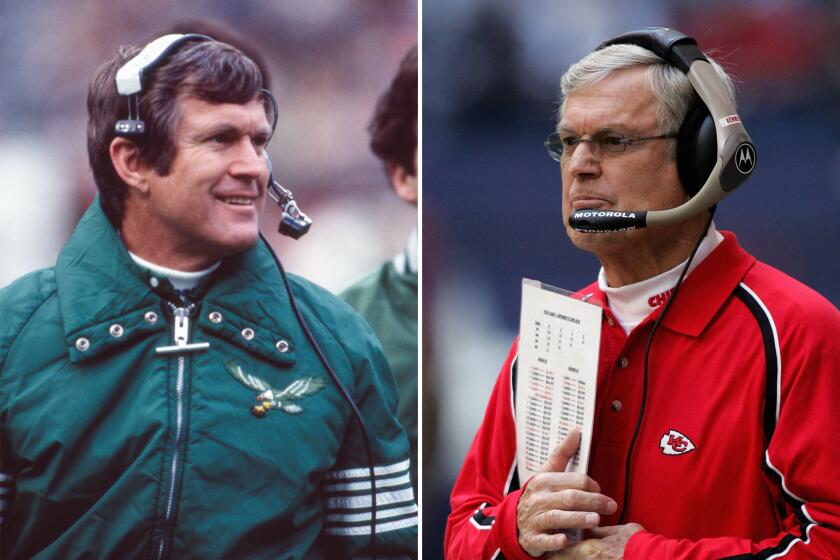Troy Davis, a True Cyclone : Iowa State Back Has a 2,000-Yard Run to Nowhere
- Share via
Think about 2,000 yards.
That’s 20 football fields, one sitting next to the other. You start running from the end zone of the first one and head for the end zone of the last one. It’s a daunting trip built on handoff after handoff, runs off tackle and guard, trap plays up the middle.
And when it’s over, waiting at the last yard, there is the Heisman Trophy, testimony that in that season, running the equivalent of 20 football fields made you the best college football player in America.
That’s how it was for Marcus Allen in 1981 and Mike Rozier in 1983 and Barry Sanders in 1988 and Rashaan Salaam in 1994.
That wasn’t how it was expected to be for Troy Davis Saturday night.
Davis was asked to the Downtown Athletic Club for the Heisman announcement, a courtesy invitation after rushing for 2,010 yards at Iowa State this season. Also invited were Eddie George and Danny Wuerffel and Tommie Frazier and Darnell Autry.
Davis had two chances for the award--slim and none.
“Anything can happen,” Davis said. “You never know. I’ve got a shot, I think. Everybody else who rushed for 2,000 yards won the Heisman. Why not me?”
Explaining how the 921 Heisman voters decide this delicate issue is no simple matter. What they don’t do, though, is vote for players from losing teams and despite Davis, Iowa State was a losing team at 3-8.
Only once in 61 years has the Heisman gone to a player whose team lost more games than it won. That was 1956 when running back Paul Hornung took the trophy home. The fact that he played at Notre Dame may have been, let’s say, a contributing factor, since that school has had more Heisman winners than any other.
Iowa State is rarely confused with Notre Dame.
Davis understood the problem and simply chose to ignore it. He went out and put up Heisman numbers and then dared the voters to ignore that.
“It wasn’t easy,” Davis said. “I played against some tough defenses.”
And he conquered them all.
He rushed for 291 yards in the season opener at Ohio University and kept right on going. He burst past 1,000 yards in five games, the first sophomore in NCAA history to do that. He led the nation in rushing with an average of 182.7 yards per game, 5.8 yards per carry, and in all-purpose yards with 224.2 per game. He finished with a flair, rushing for 183 yards against Kansas State and 180 against Missouri.
Davis remembered a conversation with a friend late in the season. “He said, ‘You could get by 1,800.’ I said, ‘I think I’ll get 2,000.’ The next thing I knew, I had the 2,000.”
On some fronts it was, well, unexpected. A year ago, Davis carried the ball 35 times all season and thought about leaving Iowa State. “I didn’t like the offense,” he said. “I wasn’t getting the playing time.”
New coach Dan McCarney promised changes, an offense built around the 5-foot-8 running back. “He asked me how many times I wanted the ball,” Davis said. “I told him to give it to me as much as he could and he did.”
There were 40 carries in the opener--five more than that entire freshman season--and 345 rushes and 20 football fields worth of yards for the year.
Suppose Davis had played on a team with a better record, a team like, oh, say, Miami, which is where he happened to grow up.
No chance.
“I spent all my life in Miami,” he said. “I wanted to look at something new.”
Something like snow.
There is a limit to how much sun and sand a body can endure. Who needs shorts in December when there are parkas and boots just waiting out there?
When Davis went on his recruiting visit to Iowa State, he was dazzled by all that white stuff, especially since he didn’t have to shovel it. He was so impressed that he tried to take some of it home.
“I put it in a bottle,” he said. “I got on the plane in Des Moines and had to change at St. Louis.”
When he got to Miami, Davis took out the bottle. Bad news.
“It was all water.”
More to Read
Go beyond the scoreboard
Get the latest on L.A.'s teams in the daily Sports Report newsletter.
You may occasionally receive promotional content from the Los Angeles Times.










